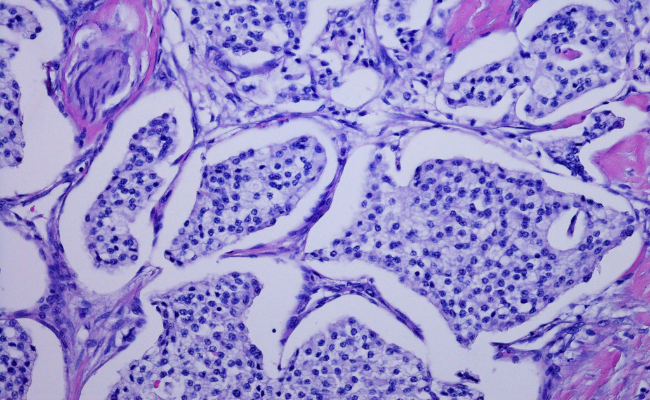How to Treat Neuroendocrine Tumour?
- January 04, 2024
- No Comments

What is Neuroendocrine Tumor?
Neuroendocrine tumors (NETs) are a rare form of neoplasm originating from specialized cells that exhibit characteristics of both nerve cells and hormone-producing cells. Scattered throughout the body, particularly in the digestive system and lungs, these tumors can either be benign or malignant. Notably, their unique ability to produce hormones results in a diverse array of symptoms, underscoring the complexity of their impact on the body.
These tumors form within the intricate network of the neuroendocrine system, where nerve cells and hormone-producing endocrine cells are intricately linked, connecting the nervous and endocrine systems. The diversity of NETs is reflected in various types and sub-types, each presenting symptoms that may initially be mistaken for less severe conditions. Formerly classified as a rare cancer, the landscape of NET diagnoses has shifted with advancements in diagnostic tests, facilitating quicker and more accurate identification. This progress has led to a growing number of individuals being diagnosed at earlier stages, showcasing the positive influence of early intervention on extended periods of living with NET and improved long-term outcomes.
Why is Treatment Necessary?
The necessity for treating neuroendocrine tumors arises from their potential to become malignant and spread to other parts of the body. Additionally, these tumors can overproduce hormones, causing a range of symptoms such as flushing, diarrhea, and abdominal pain. Treatment aims to control the growth of the tumor, alleviate symptoms, and improve the patient's overall quality of life.
How to Treat Neuroendocrine Tumors?
- Surgery: Surgery is often the primary treatment for localized neuroendocrine tumors. The goal is to remove the tumor completely. In some cases, this may involve removing part or all of an organ. Surgical intervention is most effective when the tumor is localized and has not spread to other tissues.
- Somatostatin Analogs: These medications, such as octreotide and lanreotide, work by inhibiting the production of hormones from neuroendocrine tumors. They can help control symptoms like diarrhea and flushing and may also slow down the growth of tumors.
- Targeted Therapies: Drugs that target specific molecules involved in the growth and survival of cancer cells are used in the treatment of neuroendocrine tumors. Everolimus and sunitinib are examples of targeted therapies that may be prescribed to control tumor growth.
- Peptide Receptor Radionuclide Therapy (PRRT): PRRT is a type of targeted therapy that uses a radioactive substance attached to a small molecule called a peptide. This combination seeks out and binds to neuroendocrine tumor cells, delivering radiation directly to the cancer cells.
- Chemotherapy: In cases where the tumor has spread extensively or cannot be surgically removed, chemotherapy may be recommended. Chemotherapy drugs work by targeting and killing rapidly dividing cells, including cancer cells.
- Radiation Therapy: Radiation therapy uses high-energy rays to target and destroy cancer cells. It is commonly used to shrink tumors before surgery or to relieve symptoms in cases where complete removal of the tumor is not possible.
Treatment Solutions for Neuroendocrine Tumors:
- Multidisciplinary Approach: Neuroendocrine tumors often require a multidisciplinary approach involving various specialists such as surgeons, medical oncologists, radiation oncologists, and gastroenterologists. This collaborative effort ensures a comprehensive treatment plan tailored to the individual patient.
- Regular Monitoring and Imaging: Continuous monitoring through imaging studies such as CT scans, MRI, and nuclear medicine scans is crucial to assess the progression of neuroendocrine tumors. Regular follow-ups allow for prompt adjustments to the treatment plan if needed.
- Nutritional Support: Patients with neuroendocrine tumors may experience symptoms like diarrhea and malabsorption, leading to nutritional deficiencies. Nutritional support, including dietary modifications and supplements, plays a vital role in managing these symptoms and maintaining overall health.
Benefits of Treating Neuroendocrine Tumors:
- Symptom Control: Treatment helps alleviate symptoms associated with neuroendocrine tumors, such as flushing, diarrhea, abdominal pain, and hormonal imbalances. This contributes to an improved quality of life for patients.
- Disease Stabilization: Many treatment modalities, including surgery, targeted therapies, and PRRT, aim to stabilize or slow down the growth of neuroendocrine tumors. This can prevent further complications and extend survival.
- Enhanced Survival Rates: Early detection and appropriate treatment significantly improve the prognosis for patients with neuroendocrine tumors. Advances in medical therapies and surgical techniques contribute to increased survival rates.
- Improved Quality of Life: By managing symptoms and controlling the progression of the disease, treatment enhances the overall quality of life for individuals living with neuroendocrine tumors. This includes relief from pain, improved physical function, and emotional well-being.
Comments (0)